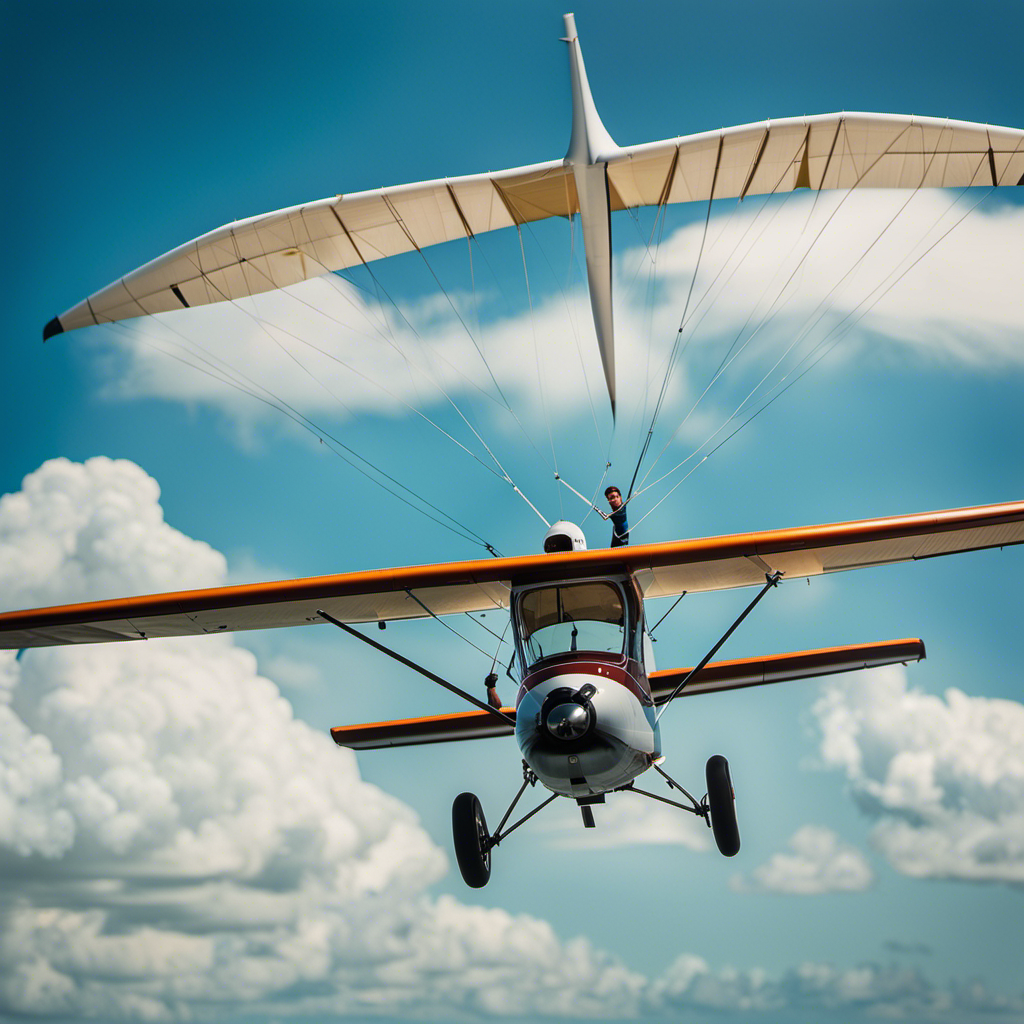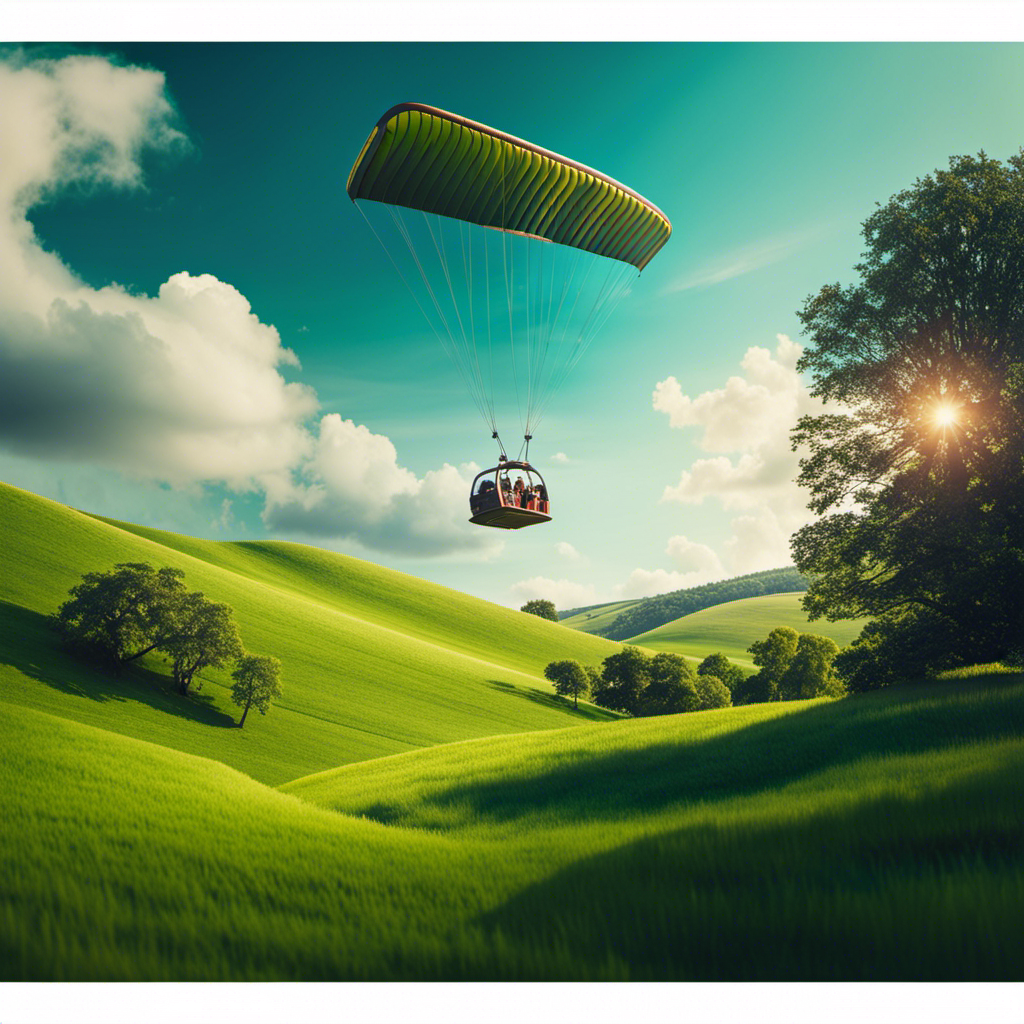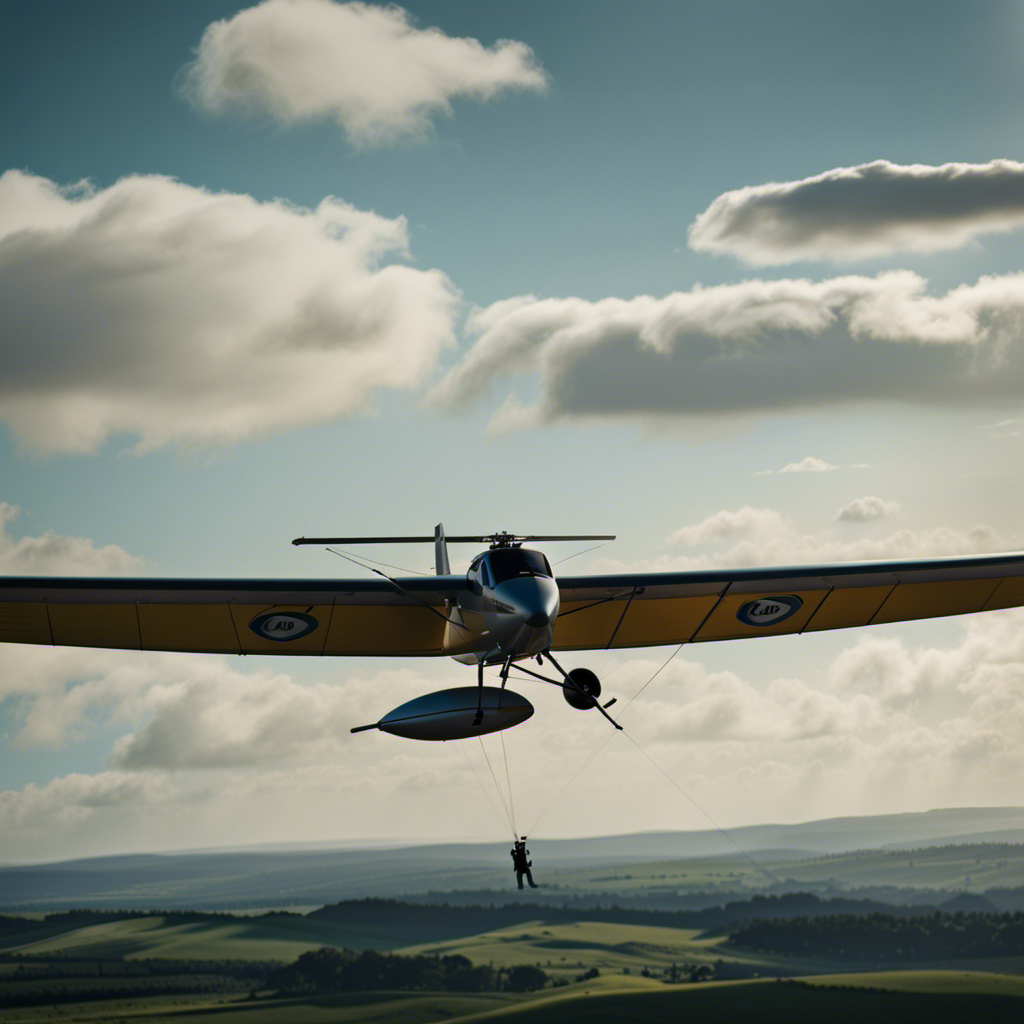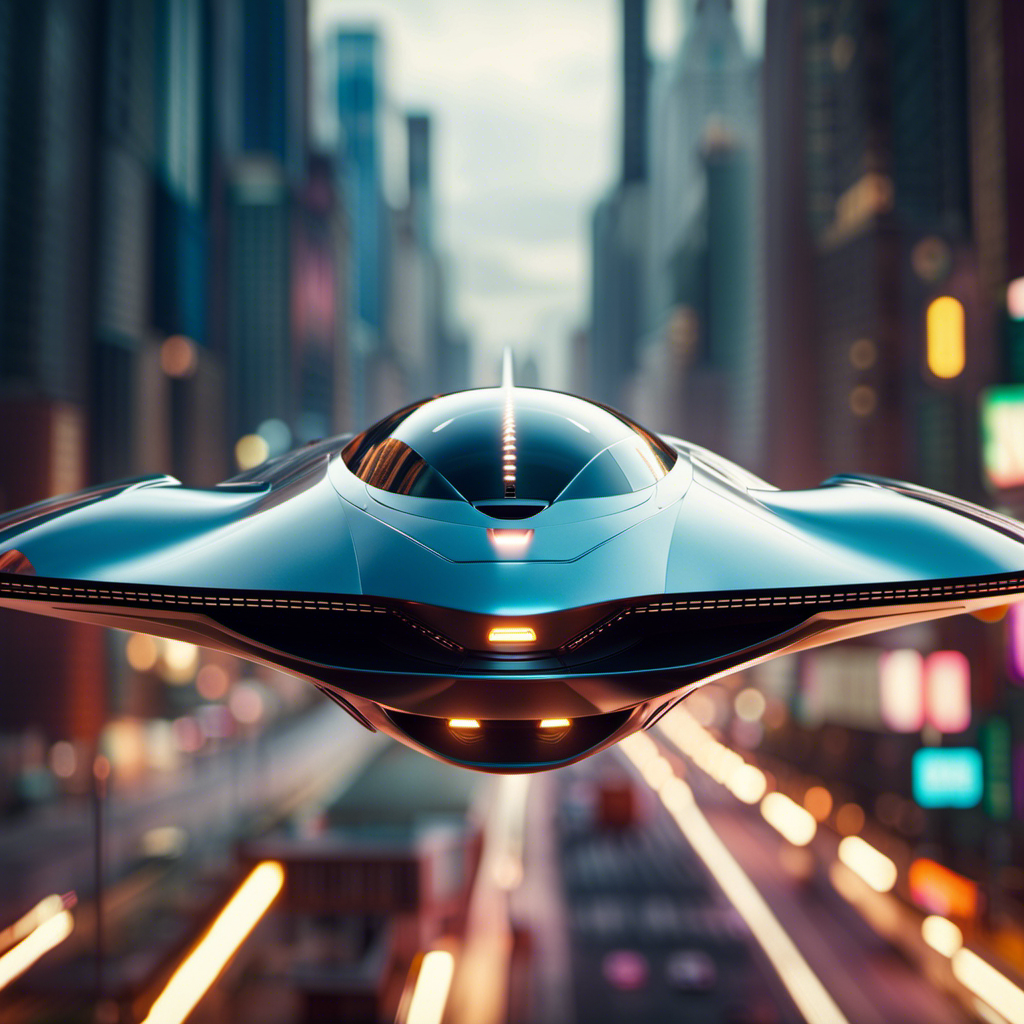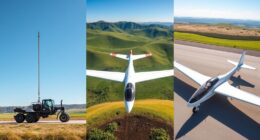Have you ever wondered about the steps involved for a private pilot like myself to become a glider pilot? Allow me to explain – it’s an exciting and challenging journey.
In this article, I will share with you the steps and skills needed to make the transition. From understanding the differences between powered aircraft and gliders, to obtaining a glider pilot license, and mastering the techniques of launching and landing, I’ll provide you with all the information you need to soar through the skies with grace and confidence.
Key Takeaways
- Connect with experienced glider pilots to learn from their expertise
- Gain access to valuable resources such as flight manuals, training materials, and safety guidelines
- Participate in regular training opportunities and workshops to continuously improve skills
- Surround yourself with a community of glider pilots to engage in discussions, observe techniques, and share experiences
Understand the Differences Between Powered Aircraft and Gliders
To become a glider pilot, you’ll need to understand the differences between powered aircraft and gliders. Understanding aerodynamics is crucial in this regard.
While powered aircraft rely on engines to generate thrust and maintain flight, gliders are unpowered and depend on natural forces, such as air currents and gravity, to stay aloft.
Exploring the joy of gliding is a unique experience that allows pilots to fully appreciate the beauty of flight without the noise and vibration of an engine. Gliders offer a sense of freedom and tranquility that is unparalleled.
Transitioning from powered aircraft to gliders requires a shift in mindset and a deeper understanding of how to maneuver and utilize available energy sources. Once you grasp these differences, you’ll be ready to obtain a glider pilot license and take to the skies in this remarkable aircraft.
Obtain a Glider Pilot License
You can obtain a glider pilot license by completing the necessary training and passing the required exams. Obtaining a glider pilot license opens up a whole new world of aviation for you to explore.
Glider flying offers a unique and exhilarating experience that is quite different from flying powered aircraft. The benefits of glider flying are numerous.
First, it allows you to experience the freedom of soaring through the sky without an engine. You can also enjoy longer flight times as gliders can stay aloft for extended periods using thermals and updrafts.
Additionally, glider flying can improve your piloting skills as it requires a greater understanding of aerodynamics and weather patterns. Learning to fly a glider will teach you the principles of soaring, which is essential for successful glider flights.
Learn the Principles of Soaring
Learning the principles of soaring in a glider provides a deeper understanding of aerodynamics and weather patterns. As a glider pilot, I have come to appreciate the intricacies of harnessing thermals to stay aloft and extend my flight time.
Thermals are columns of rising air created by the sun heating the ground, and understanding how to navigate them is essential for efficient glider flight. Additionally, mastering the glider flight controls is crucial for maintaining control and maneuvering through different flight conditions. The combination of weight shifting, using the control stick, and adjusting the airbrakes allows me to maintain stability and make precise movements in the air.
By learning these principles, I have been able to maximize my flight experiences and truly connect with the elements.
Now, let’s delve into the techniques of launching and landing, which are equally important in the world of glider piloting.
Master the Techniques of Launching and Landing
When launching a glider, it’s important to maintain a steady climb and monitor your airspeed. Launch techniques for gliders are crucial for a successful flight.
One common method is the winch launch, where a cable attached to the glider is rapidly reeled in by a powerful winch, propelling the glider into the air. Another technique is the aerotow, where a powered aircraft tows the glider using a tow rope until it reaches the desired altitude.
Landing techniques for gliders are equally important. The most common approach is the final glide, where the pilot carefully calculates the descent rate and timing to ensure a smooth touchdown. Other methods include the side slip and the spot landing, which require precise control of the glider’s position and speed.
Mastering these launch and landing techniques is essential for safe and enjoyable glider flying. As a glider pilot, developing situational awareness will further enhance your flying skills and decision-making abilities.
Develop Situational Awareness in Glider Flying
To develop situational awareness in glider flying, it’s crucial to constantly assess your surroundings and anticipate potential hazards. Enhancing spatial awareness is key, as it allows you to understand your position in relation to other aircraft and objects in the sky. This awareness helps you make informed decisions and avoid collisions.
Additionally, developing a sense of thermals is essential. Thermals are pockets of rising air that glider pilots use to gain altitude and extend their flight time. By learning to recognize the signs of a thermal, such as bird activity or cloud formations, you can effectively navigate and utilize these upward currents.
With enhanced situational awareness and a developed sense of thermals, you will be well-equipped to safely and efficiently navigate the skies. This knowledge is especially important as you gain experience in different weather conditions, allowing you to adapt and make informed decisions.
Gain Experience in Different Weather Conditions
As you gain experience in different weather conditions, it’s important to pay attention to changes in wind direction and speed, as they can greatly affect your glider’s performance.
Before taking off, conducting thorough pre-flight checks is crucial in glider flying. This includes inspecting the aircraft’s structure, controls, and instruments, as well as checking the weather forecast and assessing the conditions at the airfield.
Once in the air, flying in turbulent weather conditions requires specific techniques. Staying alert and maintaining a firm grip on the controls is essential. In turbulent conditions, it’s important to anticipate sudden changes in wind and make necessary adjustments to your flight path.
Build Confidence in Decision Making and Problem Solving
As I build confidence in decision making and problem solving, I remember to trust my instincts and rely on my training to guide me through challenging situations. Building resilience is crucial in becoming a successful glider pilot.
Here are some key ways to improve decision making skills:
- Analyze the situation: Assess weather conditions, terrain, and other factors that may impact the flight.
- Seek advice: Consult with experienced glider pilots and instructors to gain valuable insights and perspectives.
- Simulate scenarios: Practice decision making in a simulated environment to enhance critical thinking skills.
- Learn from mistakes: Reflect on past experiences and identify areas for improvement.
Stay Updated with Glider Flight Regulations and Safety Practices
Staying updated with glider flight regulations and safety practices is crucial for maintaining a safe and successful flying experience. As a knowledgeable and experienced glider pilot, I understand the importance of keeping up with the latest rules and regulations in the world of glider flight.
Glider flight competitions and events are not only thrilling but also provide an opportunity to learn from other pilots and stay updated on the latest techniques and safety practices.
When flying in mountainous regions, it is essential to take additional safety precautions due to the unique challenges presented by the terrain. These precautions include carefully planning routes, understanding local weather patterns, and maintaining clear communication with air traffic control.
By staying informed and prepared, we can ensure a safe and enjoyable glider flying experience.
As we explore the next section about joining a glider flying club or community, we will further delve into the benefits of connecting with fellow pilots and sharing knowledge and experiences.
Join a Glider Flying Club or Community
Joining a glider flying club or community offers many benefits. You can connect with experienced pilots and gain access to valuable resources and training opportunities. As someone involved in glider flying for years, I can attest to the importance of joining a club or community to enhance your skills and knowledge. Here are three reasons why becoming part of a glider flying club or community is beneficial:
-
Learning from experienced pilots: By joining a club or community, you have the opportunity to connect with seasoned glider pilots. They can share their expertise and teach you advanced glider flying techniques.
-
Access to resources: Being part of a club means having access to a wealth of resources. This includes flight manuals, training materials, and safety guidelines. These resources can greatly enhance your understanding of glider flying and help you stay informed about the latest safety measures.
-
Training opportunities: Many glider flying clubs offer regular training sessions and workshops. This allows you to continuously improve your skills and stay up-to-date with the latest techniques and safety measures.
Continuously Improve and Learn from Experienced Glider Pilots
Immerse yourself in a glider flying club or community to continuously improve your skills and learn from the expertise of experienced pilots. Flying gliders requires a unique set of skills and techniques, and there’s no better way to enhance them than by surrounding yourself with seasoned glider pilots. These individuals have a wealth of knowledge and experience that can help you become a better pilot. By actively participating in club activities, such as group flights and training sessions, you’ll have the opportunity to observe and learn from their techniques and strategies. Additionally, engaging in discussions and sharing experiences with fellow glider pilots will expose you to different perspectives and continuous improvement techniques. Remember, learning from the best is a key component in becoming a proficient glider pilot.
To further emphasize the importance of learning from experienced pilots, let’s take a look at the following table:
| Benefits of Learning from Experienced Pilots | Emotional Response |
|---|---|
| Gain valuable insights and knowledge | Excitement |
| Learn from their mistakes and successes | Inspiration |
| Develop confidence in your skills | Motivation |
| Build a network of supportive peers | Encouragement |
As you can see, there are numerous benefits to immersing yourself in a glider flying club or community. Not only will you continuously improve your skills, but you’ll also develop a sense of camaraderie and belonging. So why wait? Join a glider flying club today and start your journey towards becoming a skilled glider pilot.
Frequently Asked Questions
How long does it typically take to obtain a glider pilot license?
Obtaining a glider pilot license typically takes around 20-30 hours of flight time, depending on the individual’s skills and dedication. The transition from private pilot to glider flying requires additional training and understanding of glider-specific techniques. Costs and expenses vary depending on the flight school and location.
What are the main differences between flying a powered aircraft and a glider?
Flying a glider is like dancing on air, effortlessly controlled by subtle movements. The main differences between flying a powered aircraft and a glider lie in the lack of engine power and the reliance on aerodynamic forces for control.
Are there any specific physical requirements for becoming a glider pilot?
To become a glider pilot, there are specific physical requirements and medical requirements that must be met. These include having good overall health, normal vision, and the ability to operate the controls effectively.
Can a private pilot transition to glider flying without starting from scratch?
Transitioning from being a private pilot to flying gliders doesn’t mean starting from scratch. With the right qualifications and a transition process, it’s like adding a new skill to your toolbox, expanding your aviation horizons.
Are there any additional costs or expenses associated with becoming a glider pilot?
There are additional expenses associated with becoming a glider pilot. It requires a financial commitment for training, licensing, and equipment. However, the experience and freedom of glider flying are worth the investment.
Conclusion
In conclusion, becoming a glider pilot requires dedication, perseverance, and a thirst for learning. It is a journey that takes you from the world of powered aircraft to the graceful realm of gliding.
Like a bird soaring effortlessly through the sky, a glider pilot must master the principles of soaring and develop the skills necessary for launching and landing. By continuously improving and learning from experienced glider pilots, one can navigate the challenges and complexities of glider flight with confidence and grace.
So spread your wings and embark on this exhilarating adventure of becoming a glider pilot, where the sky becomes your playground.
